Whenever I watch a sunset I know that the same light will rise upon awakening friends somewhere else in the world, and a new day will begin. Over the last few years my community of Iyengar yoga has watched several sunsets. It is a  tumultuous time in our world. On the global spectrum we are struggling for the waning resources of water and air. The political narrative of populism and nationalism seem like a resurgence from the dark ages, where feudal wars would decimate any opposition and crusades silenced free speech. My community at YogaWorks has likewise witnessed darkening skies of grief and change. Yes, we are living through the saga of a setting sun.
tumultuous time in our world. On the global spectrum we are struggling for the waning resources of water and air. The political narrative of populism and nationalism seem like a resurgence from the dark ages, where feudal wars would decimate any opposition and crusades silenced free speech. My community at YogaWorks has likewise witnessed darkening skies of grief and change. Yes, we are living through the saga of a setting sun.
Where will the sun rise? Who is waking up to change? And to new light?
Abhijata Iyengar is perhaps our Phoenix, rising from the ashes of our grief from losing both her grandfather Sri BKS Iygenar (Guruji) and most recently, her aunt Sri Geeta Iyengar (Geetaji). Abhijata (or as her students affectionately call her, Abhi) is bold, bright, gracious, welcoming, young, a mother, educated, and savvy in the ways of our international community. Abhi brings change. For the Europeans she hopes to bring some cohesion. In America, Australia and England, where assessment has become a goal oriented step ladder that has institutionalized what should be an organic process – that of studentship – Abhi has asked for a very different structure that emphasizes mentoring, personal experience and subjectivity (I will elaborate in a future post). She is asking that we join her in a dialog to explore how we can make our studies more congenial, sophisticated, layered, and cooperative.
Abhi embodies and is embracing her heritage. Having been mentored for almost twenty years by her grandfather, Guruji, and having traveled internationally to conferences with her aunt, Geetaji, Abhi has seen how a dogmatic approach can create what she calls “cookie-cutter” teachers. Every family has its struggles, and our Iyengar “family” is no exception. Abhi has been listening and watching for a decade. Now she has ideas on how to address our “issues”, and she has invited us to join her in an open dialog.
For context, she explained that, in the mid-twentieth century, yoga was unknown. Guruji initially had to promote yoga and himself through public demonstrations. The original script for Light on Yoga included three times as much material, but the publishers told him that it was too esoteric and too long for the general public. Even so, the interest in integrated body/mind practices and in Indian spirituality along with Guruji’s infectious enthusiasm caught the imagination of people on every continent. His teachings inspired the creation of Associations worldwide. Fast forward to today when everyone studies yoga (Prashant: “every Tom, Dick and Harry” is a euphemism for the everyman). Yoga, in the sense of Yoga as a body/mind/spiritual practice, has been exploited and manipulated to fit many commercial ventures. It has become an industry. Iyengar yoga has been pigeon-holed and is defined in the Oxford dictionary as a yoga that uses furniture.
Our approach to teacher training is similar, she explained. We package teacher trainings. But “can you”, she said, “honestly package spiritual studies, Svadhyaya?” Prashant is very vocal about this. Teacher Trainings (TTCs) have become “money making ventures” he frequently says. Iyengar yoga must redefine itself.
“There are two types of education; formal education, which is a set pattern, predictable, replicate, rigid format, a ‘cookie cutter.’ And the second is an informal education; it is effective, iterative, contextual, and geared to the ‘individual.’ No set rules. There is a third way. It is a non-formal way; through direct experience. It is a life-long process where science, art, and philosophy come together. How do we learn yoga? It is not linear, we grow, and we fall,” Abhi said.
She continued, “In early days we adopted the formal way because it was easier to scale and to replicate. Even though early learners learned the informal way, with refined sensitivity, we understood that the linear way is not effective. We now want to create a world that encourages curiosity.” This third path attribute is that it is “pulsatizes” (beats), it is alive, a vibrating system in resonance with reality.”
We spent seven days exploring, experiencing, and discovering ways to expand the paradigm of Iyengar yoga. Rather than orienting our practice around the familiar actions or points of an asana, both Abhi and Prashant worked with cross-categories of poses, with breath dynamics, Uddyana Kriya and steered us away from identifying Iyengar yoga as asana centric. “The core of Iyengar yoga is Yoga” Abhi said. “Connect your students and yourselves to the mother ship of Patanjali and yoga. For whatever reason a student comes to yoga, connect them to YOGA.”
How refreshing. How brave. How honest. How forward thinking. There is a sun rising, and light is upon our community.

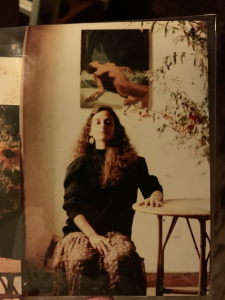 When I process deep emotions I either shut down or go manic. When I shut down it is because I am not ready to voyage into the abyss of my story. But when I go manic, I usually produce something. In the days prior to Maty Ezraty’s Celebration of Life, I burned the midnight oil in compiling a selection of photos, news articles and personal statements as a testimony to this amazing woman, titled “Maty Ezraty, A Life of Integrity.”
When I process deep emotions I either shut down or go manic. When I shut down it is because I am not ready to voyage into the abyss of my story. But when I go manic, I usually produce something. In the days prior to Maty Ezraty’s Celebration of Life, I burned the midnight oil in compiling a selection of photos, news articles and personal statements as a testimony to this amazing woman, titled “Maty Ezraty, A Life of Integrity.” The history of the first decade at YogaWorks remains in the hearts and lives of many of yoga’s most influential teachers today. Maty would invite teachers from many traditions, Viniyoga with Gary Kraftstow; Iyengar yoga with Gabriella Giubilaro, Patricia Walden, Eddie Modestini among others; Yin Yoga with Sarah Powers and Paul Grilley; Richard Freeman, Tias Little and John Friend all frequented the workshop schedule. Erich Shiffman, Rod Striker, and later Shiva Rey and Sean Korn were on daily class schedules. It was a fertile era, and many of these yogis showed up for Maty’s Celebration of Life.
The history of the first decade at YogaWorks remains in the hearts and lives of many of yoga’s most influential teachers today. Maty would invite teachers from many traditions, Viniyoga with Gary Kraftstow; Iyengar yoga with Gabriella Giubilaro, Patricia Walden, Eddie Modestini among others; Yin Yoga with Sarah Powers and Paul Grilley; Richard Freeman, Tias Little and John Friend all frequented the workshop schedule. Erich Shiffman, Rod Striker, and later Shiva Rey and Sean Korn were on daily class schedules. It was a fertile era, and many of these yogis showed up for Maty’s Celebration of Life. The page has turned once more and, as I enter the fall season, my thoughts center around my summer sabbatical. I took three months away from teaching, away from my yoga community, and entered a quiet life alongside an estuary in a small town on the coast of Oregon. It is beautiful here, with herons, pelicans, sandpipers, hawks and bald eagles circling through the air space. The rhythm of the tides leave fresh discoveries every morning along the half mile beach front where we walk. Sita, our very fluffy American Eskimo, scampers after the birds and digs for clams. She is free, I feel free, and my husband comes to life in his floppy white hat, shorts, and sandals. It is cooler here then in Santa Monica, and I generally don my scarf and down jacket.
The page has turned once more and, as I enter the fall season, my thoughts center around my summer sabbatical. I took three months away from teaching, away from my yoga community, and entered a quiet life alongside an estuary in a small town on the coast of Oregon. It is beautiful here, with herons, pelicans, sandpipers, hawks and bald eagles circling through the air space. The rhythm of the tides leave fresh discoveries every morning along the half mile beach front where we walk. Sita, our very fluffy American Eskimo, scampers after the birds and digs for clams. She is free, I feel free, and my husband comes to life in his floppy white hat, shorts, and sandals. It is cooler here then in Santa Monica, and I generally don my scarf and down jacket. Over the months I explored all variations of incorporating the breath into my practice. Sometimes it was through staying in a pose and feeling how my back lungs might widen at end of the inhalation and how the flesh beneath the skin could move freely at the end of exhalation. Or how the breath could initiate movement and guide the transitions between poses. How the natural shape of the inhalation and exhalation effects my body and each pose. Forward bends, props, long timings, back arches, slow and fast, with and without support. How luxurious to explore!
Over the months I explored all variations of incorporating the breath into my practice. Sometimes it was through staying in a pose and feeling how my back lungs might widen at end of the inhalation and how the flesh beneath the skin could move freely at the end of exhalation. Or how the breath could initiate movement and guide the transitions between poses. How the natural shape of the inhalation and exhalation effects my body and each pose. Forward bends, props, long timings, back arches, slow and fast, with and without support. How luxurious to explore!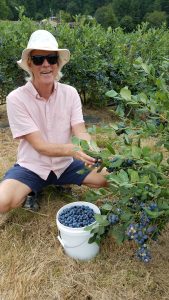 But I also find that when I begin with supports – blocks, ropes, stools – to release the grip in the back, groin and shoulder muscles and cultivate a quiet relationship with the exquisite sense of expansion, the back arches themselves come more easily.
But I also find that when I begin with supports – blocks, ropes, stools – to release the grip in the back, groin and shoulder muscles and cultivate a quiet relationship with the exquisite sense of expansion, the back arches themselves come more easily.
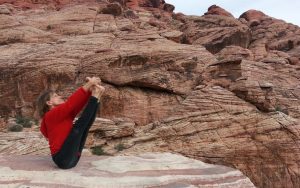 Sat. Mar. 9 & 16
Sat. Mar. 9 & 16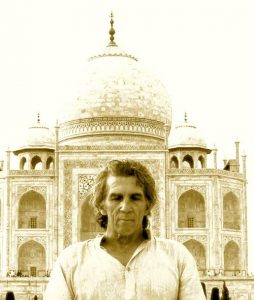
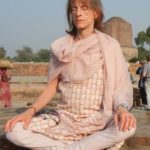 Lisa Walford teaches internationally and has taught in the Los Angeles area for over thirty years. She is certified Intermediate Senior II.
Lisa Walford teaches internationally and has taught in the Los Angeles area for over thirty years. She is certified Intermediate Senior II. This amazing embodiment! This chariot that carries us through life! The body, the breath, the brain. How intimately connected, one cannot effect any part without impacting the whole.
This amazing embodiment! This chariot that carries us through life! The body, the breath, the brain. How intimately connected, one cannot effect any part without impacting the whole.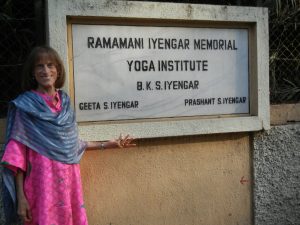 Yoga is a deeply personal experience. Guruji went to the depths of his practice to extract the essence of what it is to be human. He used his body to discover the step ladder that can take us from suffering to inner peace, and paved the path for the rest of us follow. Geeta and Prashant Iyengar, Guruji’s daughter and son, have both dedicated their lives to continuing this discovery. Geeta systematized how we practice, designed programs for women and supervised therapeutic classes. Prashant weaves esoteric elements of yoga into his teaching and bases much of his work on the breath. Each brings us a gift to unwrap through our studies.
Yoga is a deeply personal experience. Guruji went to the depths of his practice to extract the essence of what it is to be human. He used his body to discover the step ladder that can take us from suffering to inner peace, and paved the path for the rest of us follow. Geeta and Prashant Iyengar, Guruji’s daughter and son, have both dedicated their lives to continuing this discovery. Geeta systematized how we practice, designed programs for women and supervised therapeutic classes. Prashant weaves esoteric elements of yoga into his teaching and bases much of his work on the breath. Each brings us a gift to unwrap through our studies.
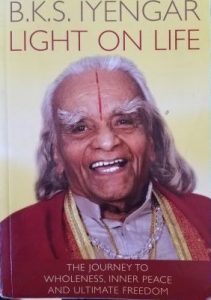 Fours Sessions of Inspiration on Life and Using the Process of Yoga to Live Fully: Apr. 7 – May 5 at IYILA.
Fours Sessions of Inspiration on Life and Using the Process of Yoga to Live Fully: Apr. 7 – May 5 at IYILA.